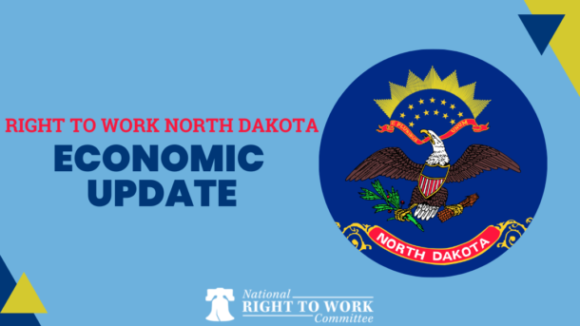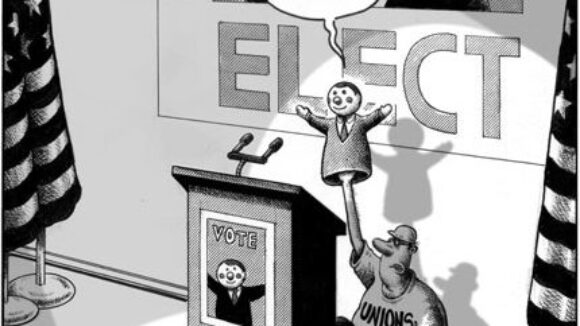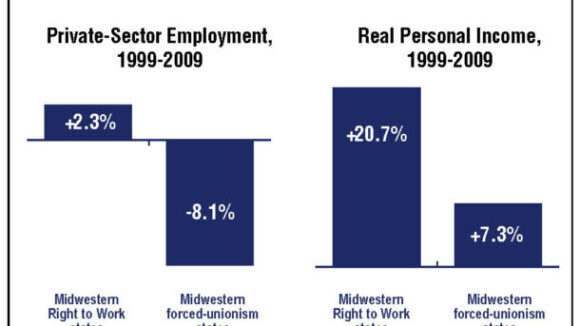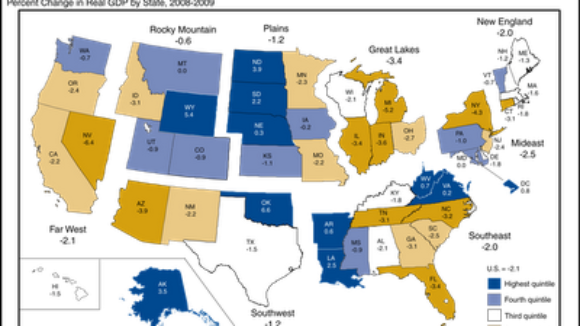Here are Businesses Investing in Right to Work North Dakota
Two businesses investing in Right to Work North Dakota are Epitome Energy and Grand Farm Education and Research Initiative.

Two businesses investing in Right to Work North Dakota are Epitome Energy and Grand Farm Education and Research Initiative.

CGB Enterprises and ADM are both adding new locations soon in Right to Work North Dakota.

Businesses investing in the Midwest include Accelerate360 in Kansas, Link Mfg in Iowa, Nucor in Nebraska, and Core Scientific in North Dakota.

The National Right to Work Committee survey program leaves pro-forced unionism candidates with a choice. They can stop acting as union-boss puppets, or they can be held accountable by freedom-loving citizens. Credit: John De Rosier-Albany (N.Y.) Times-Union Committee Program to…
CNBC’s 6th annual study of America’s Top States for Business finds, once again, that Right to Work…

UAW and BMW plan to expand in Right to Work state of South Carolina Union bosses at the United Autoworkers Union are tapping worker’s strike funds to fund a crusade to force auto workers in Right to Work states into…

(Source: December 2010 NRTWC Newsletter) In every region of the country where both Right to Work states and forced-unionism states are located, the Right to Work states' long-term economic growth is superior. The Midwestern contrast is especially strong. Legislators Look at 'Oklahoma Model' For Stronger Economic Growth It's been more than seven decades since The Grapes of Wrath, both the John Steinbeck novel and the Hollywood movie it inspired, established the desperate migration of "Okies" from the Dust Bowl to the orchards of California as an icon of the Great Depression. Times have certainly changed. As an October 12 USA Today feature story noted, since 1999, "the number of Californians departing the Golden State for Oklahoma has outnumbered those going the opposite direction by more than 21,000 . . . ." The net influx of people into the Sooner State from California and many other states with sub-par or abysmal job and income growth records is, as USA Today put it, "a sign of Oklahoma's growing economic prowess." To explain the state's recent record of economic success, the USA Today feature specifically mentioned Oklahoma's low and relatively stable housing costs, its concentration of aerospace and defense technology expertise, and its oil and natural gas reserves. But as important as these assets are, Oklahoma had them all in the early 1990's, when its long-term job and income growth still trailed the national average. The real turning point for Oklahoma's transition from an economic laggard to an economic leader was in 1992 -- when the National Right to Work Committee teamed up with local grass-roots activists to map out a multi-year campaign to pass a Sooner Right to Work law. Benefits of Right to Work Campaign Were Evident Long Before State Law Was Passed "In the early 1990's, the 'Dust Bowl' was already a distant memory, but Oklahoma's job climate still seemed pretty dry," commented Matthew Leen, vice president of the National Right to Work Committee. Domestic population migration data reflect Oklahoma's "growing economic prowess." The 1994-2001 Sooner State campaign to pass a Right to Work law, as well as the law itself, helped build that prowess. "From 1984 through 1994, the decade before the Committee program to pass a Right to Work law in Oklahoma was initiated, private-sector employment in Oklahoma increased by less than a third as much as the national average, according to the U.S. Labor Department. "Over that same decade, inflation-adjusted U.S. Commerce Department data show Oklahoma's real personal income grew by just 2.3%, less than a tenth of the nationwide percentage gain. "But in 1994, the seeds of change were

Mark Perry looks at the economic performance of Right to Work states in comparison to forced unionism states and provides further evidence that Right to Work states foster prosperity. In the economic downturn year of 2009, forced unionism…

(Source: August 2010 NRTWC Newsletter) Grass-Roots Right to Work Efforts Expanding in Midwestern States Pro-forced unionism politicians like Gov. Jennifer Granholm (D-Mich., shown here with former Vice President Gore and President Obama) have lost credibility due to the extraordinarily poor economic performance of forced-unionism states. Credit: Radiospike.com All across America, Right to Work states have long benefited from economic growth far superior to that of states in which millions of employees are forced to join or pay dues or fees to a labor union just to keep their jobs. But over the past decade, the contrast between Right to Work states and forced-union-dues states has been especially stark in the Midwest. Four Midwestern forced-unionism states -- Michigan, Ohio, Illinois and Indiana -- suffered absolute private-sector job declines over the past decade that were worse than those of any of the other 46 states. Midwestern forced-unionism states (the four just mentioned, plus Missouri, Wisconsin and Minnesota) lost a net total of 1.88 million private-sector jobs. Combined, these seven forced-unionism states had 8.1% fewer private-sector jobs in 2009 than they did back in 1999. Meanwhile, the five Midwestern Right to Work states (North Dakota, Nebraska, South Dakota, Iowa and Kansas) experienced an overall private-sector job increase of 2.3%. Moreover, from 1999 to 2009, real personal income in Midwestern Right to Work states grew by 17.3% -- an increase two-and-a-half times as a great as the combined real personal income growth in Midwestern forced-unionism states. State Right to Work laws prohibit the firing of employees simply for exercising their right to refuse to join or bankroll an unwanted union. At this time, 22 states have Right to Work laws on the books. However, because of intensifying grass-roots efforts in many of the remaining 28 forced-unionism states, the number of Right to Work states could be on the rise over the course of the next few years. Recession's End Won't Suffice to Revive Big Labor-Controlled States